Introduction: Mary Harrell-Sesniak is a genealogist, author and editor with a strong technology background. In this blog article, Mary gives practical tips on how to document and preserve your precious family heirlooms.
Passing on cherished heirlooms is a time-honored tradition – one that predates all of us for as long as history has been recorded. Your belongings may become the heirlooms of tomorrow, but only if you take care of them.
Unfortunately, many family heirlooms become lost through the ages, mostly due to:
- lack of proper care
- exposure to harmful substances and environments
- incomplete provenance
- overlooking the need for the provenance
- providing only an oral, not a written history
My Family Heirloom: Box of Lace & Handicrafts
A good example of a family heirloom is a box of lace and handicrafts handed down in my family. The box is full of charming little handicrafts which I adore – and luckily for me, the items have been well preserved.
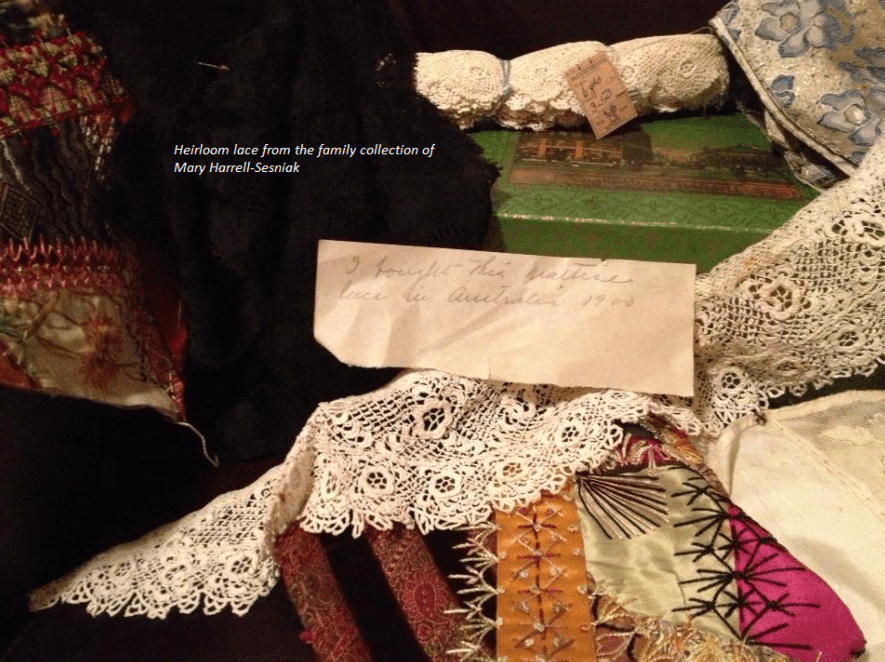
This vintage heirloom box contains dozens of small treasures, some even with the original price tag. The bundle of dainty lace at the top of the photo has a tag reporting six yards that cost $3.50 from McCutcheon’s of New York. Some of the frilly handicrafts in the box were handmade. There are two crazy quilt blocks consistent with a larger quilt made by my 2nd great grandmother and other garment parts – some partially completed, and others which appear to have been removed from existing clothing. Then there is a lovely little unsigned note which reads:
I bought this Maltese lace in Australia 1900.
When you read a note like this from one of your ancestors, you immediately long for more details.
Luckily I recognized the handwriting, and from other family documents determined which ancestors sailed to Australia in 1900. It was my maternal great grandparents – and fortunately for us, there are several heirlooms and stories connected to their trip.
Research Your Heirloom in Old Newspapers
I was intrigued about the note, but didn’t know which object in the box was the “Maltese lace.” So I turned to the old newspaper archives to do further research.
A query of Genealogy Bank’s Historical Newspaper Archives showed that by 1904, this type of adornment had reached the height of popularity. For example, this 1904 newspaper fashion article features a photo of a stylish silk suit. The woman’s garment is decorated with “a narrow edging of gray Maltese lace defining the yoke.”
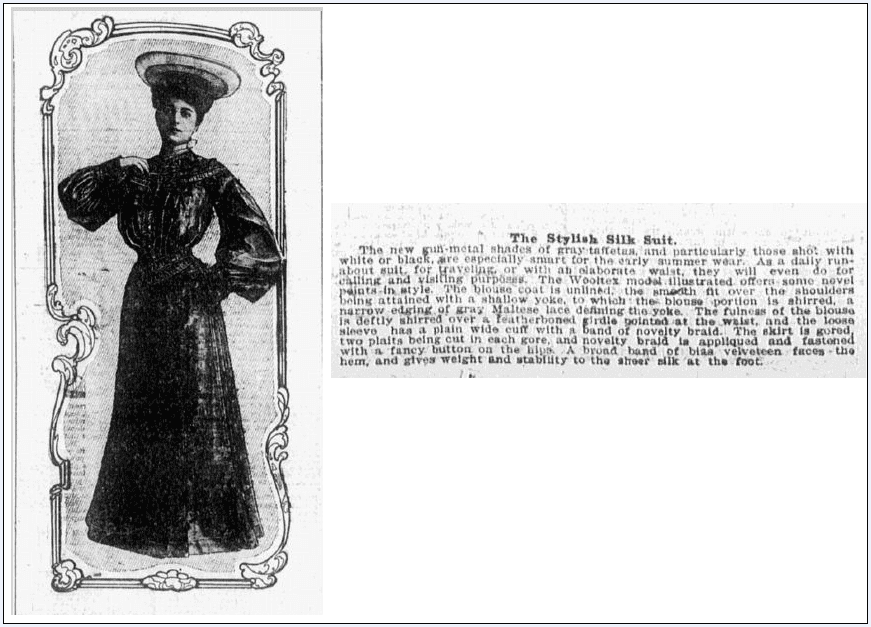
I found a good description of Maltese lace in another 1904 newspaper article:
Maltese lace is finely wrought, but very open in pattern, so that the decorative design stands boldly, if delicately, out from a background of fairy-like stitches in an open mesh. Made of the finest of silk threads, it has a creamy glow about it that is exceedingly becoming to the face, and it is peculiarly harmonious when worn with silk and velvet.
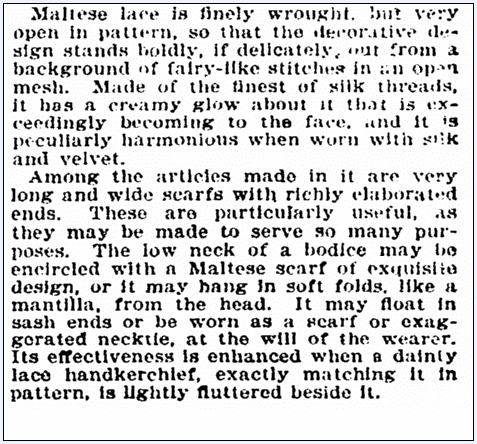
With these clues, the choice of which object in the box is the Maltese lace became obvious. I just looked for something with fairy-like stitching that might also be a scarf or mantilla. Although this picture doesn’t do it justice, I believe this is it.
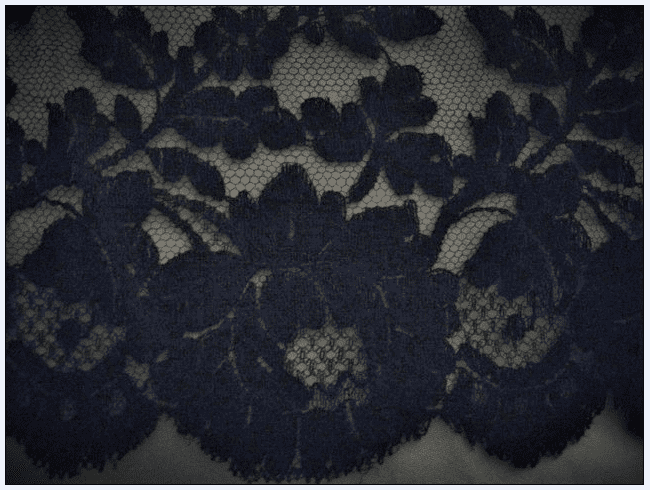
Research Tip: While newspapers are a great resource to research your ancestors directly (their stories as well as their vital statistics), newspapers can also be used to research other aspects of their lives (such as their personal items, their communities, and the times they lived in).
Enhancing the Provenance of Family Heirlooms
Appraisers advise that provenance (establishing the origin of an object, and its past owners) adds value to an antique or heirloom, and a large component of this is writing down the object’s history.
So don’t make the mistake made by many families – if you know the heirloom’s story, don’t just tell it, write it down! Document the heirloom’s time period and ownership, and list yourself as the recorder. Add a note in your own handwriting – or if typed, include an original signature. Here are some suggestions for documenting your heirloom:
- This (description of the item) was given to me (your name) on or about (date) by (name), who was my (relationship).
- I was told by (name) that this heirloom was made by (name).
- This heirloom was passed down through the (maternal or paternal) side of my family and given to me on (special occasion).
- This heirloom did not pass through the family. I found it at an antique shop in (place) around (year). I love it because (description).
- This note is believed to have been written by (name) of (location), as the writing is similar to a (letter, will, etc.) written on (date).
Don’t forget that you are part of the provenance. My heirloom lace in the box now has a second note:
This piece of Maltese lace was identified by Mary Harrell-Sesniak, in February of 2015.
Care and Handling of Family Heirlooms
Don’t neglect to learn about the proper care of your family heirloom. If something has broken, make sure modern materials won’t harm it before attempting a repair. Get an expert to fix it, or learn how to use traditional materials for your own repair.
As my family learned with an early American antique chest, it is better to use a traditional, natural glue than more modern products that might contain acid or wood-destroying chemicals.
Library of Congress Has Heirloom Preservation Tips
The Library of Congress is the keeper of many of our country’s treasures. As such, they have accumulated much expertise, and have created numerous guides about preservation of works of art, documents, and other objects that might be in your family heirloom collection. Many heirloom preservation tips are found in the Collections Care section of their website.
Here you will learn about determining the material and condition of your heirloom. The material it is made from will determine much of its care. There are different guidelines for different materials, whether they are artwork, paper, textiles, photographs, metal, wood, ceramics or other fine materials.
In general terms, however, there are a few universal guidelines: avoid
- uneven temperatures
- materials with acid
- handling without gloves (your fingers can damage items)
- light
As the Library of Congress notes in their guide Why should you care about light damage:
Light causes permanent and irreversible damage that affects the chemical composition, physical structure, and, what is usually most obvious, the appearance of the collection item… There are no conservation treatments that can undo light damage.
Expert Advice for Documenting & Preserving Your Family Heirlooms
In addition to the ideas in this Blog article about documenting and preserving your heirloom, be sure to network with experts for further advice – and never underestimate the power of social media. Look for special pages on Facebook, Pinterest and Google+ about family heirlooms. You’ll often encounter an expert commenting on the same social media pages you frequent.
Sources for additional heirloom advice:
- antique experts
- appraisers
- curators
- fine auction houses
- historical societies
- reference guides
- social media groups
I’ll conclude with this photo of a very fine collection of silverware:
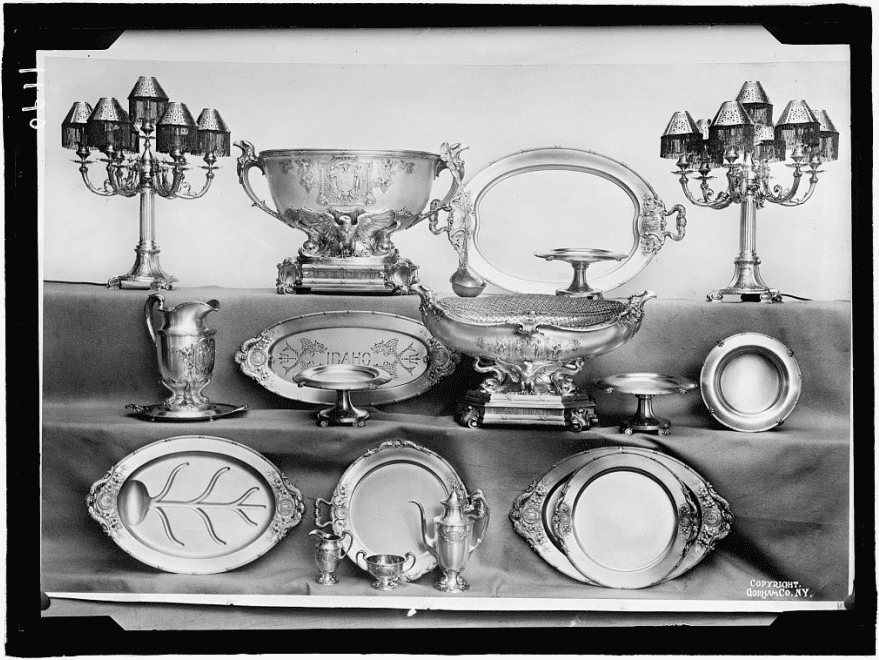
Tell us about your own family heirlooms in the comments section, especially any advice you have about documenting and preserving your cherished items.
Related Heirloom Articles:

I just received the christening gown that my grandma and all 11 of her siblings were baptized in, between the years of 1914 and 1932. It’s in excellent condition and I truly hope to be able to keep it that way.
Roni
What an exciting treasure. Thank you for sharing this exciting find. Don’t forget to store it appropriately so future generations will have the pleasure of seeing it.
Mary
I inherited my paternal 2xgreat grandfather’s trunk. He was a minister in Ohio late 19th century. The small trunk is covered in animal hide (elk?) and has his initials in tacks. My husband teases me about the fuzzy trunk, but having lasted this long it isn’t leaving the house any time soon!
Nancy,
Thank you for sharing the story of this family treasure. It sounds like an absolute gem.
Mary
Thank you all very much for creating this very useful site. I inherited an ornate, hand-woven lace tablecloth that my mother’s paternal aunt, Rose, wove in 1932 in New York City. No damage that I can see. Am attempting to create a provenance for it to send to my sister, in case she wants to bequeath it to one of her grown daughters. (I am childless.) Would it help if I hired a formal appraiser? Thank you again for your kind attention in reading this.
Hi Charles,
You are welcome. Thank you for contacting us. The GenealogyBank blog has an interesting assortment of articles and it’s been a pleasure to be a contributor.
I think it is wonderful that you are passing your aunt’s hand woven tablecloth to your sister. The provenance you provide will be a family treasure for years to come.
An appraisal is always an important idea.
Try to find an expert in textiles, rather than one who specializes in other areas, so that you can choose the proper way to store the heirloom. Many get advice from curators or take their items to companies who work with wedding dresses. With textiles, it’s important to consider acid free tissue paper and archival storage options. You may also be guided as to how to best fold the material.